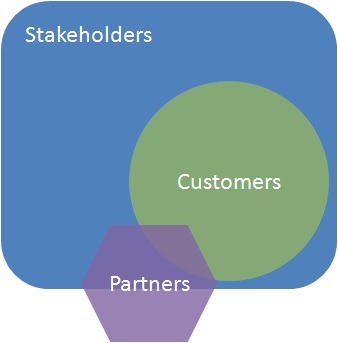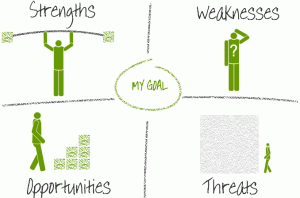Strategic planning, as a structured and systematic process, is successful when it is leader-led and overcomes the five reasons 70% of all strategies fail. Learn how to see your plan through to success. The strategic planning process is where leaders of an organization establish the vision of the organization’s future and then develop and implement the actions necessary to achieve that future. This article expands on the strategic planning concepts addressed in Think Big, Take Small Steps and is designed to help you achieve success in your strategic planning process.
Several weeks ago, I talked about Application of Scenario Planning in Strategic Planning. Then, we discussed the actual building of the potential scenarios to address possible future occurrences. Now, in the Facilitation of an Effective Strategic Plan Offsite, we use scenario planning to generate potential ideas around what an organization should strategically consider.
Let me provide you with an example of a scenario that I used before with military privatized housing.
First, you should develop three to five scenarios that address potential concerns that you identified in the blogs covering How to Conduct an Organizational Assessment. Review them with the senior person you are working with and narrow these down to three. Any more probably is too much.
We’re not talking about aliens landing and capturing market share…focus on potential future events that are based in reality. if you look at the above example, this proved to be a very possible event and raised concerns that the military determined to strategically deal with.
There are two ways to primarily address a scenario. The example above provide the first way and that is to point out a potential vulnerability in current operations allowing the senior leadership to discuss and determine potential ways to mitigate the strategic risk. If the organization already has a mission, vision, and goals, I like to provide scenarios that challenge their current strategy and have them determine if the strategy is still valid or does it need to be changed.
Either way, these are used to promote discussion, which leads eventually action items that I talked about last blog in Building a Strategic Plan from the Bottom Up.
My recommendation is that you have fun with the scenarios, but be realistic. I have found that senior leadership enjoy thinking about the strategic what ifs and discussing them. You just don’t want to do this too much during your offsite, or overuse the approach because the leaders will wonder if the plan is being built off reality or fiction.
So, 70% of all plans fail to some level; however, by following these guidelines you can help ensure your strategic plan will be one of the 30% successes that everyone reads about.















 Strategic planning, as a structured and systematic process, is successful when it is leader-led and overcomes the five reasons 70% of all strategies fail. Learn how to see your plan through to success. The strategic planning process is where leaders of an organization establish the vision of the organization’s future and then develop and implement the actions necessary to achieve that future. This article expands on the strategic planning concepts addressed in
Strategic planning, as a structured and systematic process, is successful when it is leader-led and overcomes the five reasons 70% of all strategies fail. Learn how to see your plan through to success. The strategic planning process is where leaders of an organization establish the vision of the organization’s future and then develop and implement the actions necessary to achieve that future. This article expands on the strategic planning concepts addressed in 
 Strategic planning, as a structured and systematic process, is successful when it is leader-led and overcomes the five reasons 70% of all strategies fail. Learn how to see your plan through to success. The strategic planning process is where leaders of an organization establish the vision of the organization’s future and then develop and implement the actions necessary to achieve that future. This article expands on the strategic planning concepts addressed in
Strategic planning, as a structured and systematic process, is successful when it is leader-led and overcomes the five reasons 70% of all strategies fail. Learn how to see your plan through to success. The strategic planning process is where leaders of an organization establish the vision of the organization’s future and then develop and implement the actions necessary to achieve that future. This article expands on the strategic planning concepts addressed in 



 Strategic planning, as a structured and systematic process, is successful when it is leader-led and overcomes the five reasons 70% of all strategies fail. Learn how to see your plan through to success. The strategic planning process is where leaders of an organization establish the vision of the organization’s future and then develop and implement the actions necessary to achieve that future. This article expands on the strategic planning concepts addressed in
Strategic planning, as a structured and systematic process, is successful when it is leader-led and overcomes the five reasons 70% of all strategies fail. Learn how to see your plan through to success. The strategic planning process is where leaders of an organization establish the vision of the organization’s future and then develop and implement the actions necessary to achieve that future. This article expands on the strategic planning concepts addressed in 
 Strength. Strengths are internally positive aspects about the organization. These are the things that make the organization strong and are the main things an organization can leverage to overcome internal weaknesses and external threats. Organizations tend to focus only on their weaknesses and take their strengths for granted. A failure to focus on and nurture your organizational strengths can quickly turn them into a negative. When you brainstorm to build a SWOT, you tend to come up with a lot of perceived strengths, some of which might not be true.
Strength. Strengths are internally positive aspects about the organization. These are the things that make the organization strong and are the main things an organization can leverage to overcome internal weaknesses and external threats. Organizations tend to focus only on their weaknesses and take their strengths for granted. A failure to focus on and nurture your organizational strengths can quickly turn them into a negative. When you brainstorm to build a SWOT, you tend to come up with a lot of perceived strengths, some of which might not be true. Weakness. Weaknesses are also internal to the organization, but these are the challenges that could prevent the organization from achieving its eventual vision. Only the most glaring weaknesses are normally highlighted by an organization when brainstorming and usually this list is short. When done correctly, this tends to be a long and difficult list for leaders to swallow. Although it doesn’t sound like SWOT, I often refer to this box as Challenges (a SCOT). Nothing in an organization will prevent it from achieving its vision, unless they fail to address the challenges in front of them.
Weakness. Weaknesses are also internal to the organization, but these are the challenges that could prevent the organization from achieving its eventual vision. Only the most glaring weaknesses are normally highlighted by an organization when brainstorming and usually this list is short. When done correctly, this tends to be a long and difficult list for leaders to swallow. Although it doesn’t sound like SWOT, I often refer to this box as Challenges (a SCOT). Nothing in an organization will prevent it from achieving its vision, unless they fail to address the challenges in front of them. Opportunity. Many times Opportunities and Threats can be the same thing, but simply it’s the way you look at them. Basically, these both fall into a risk category. Opportunities are positive and external to the organization. If you have an opportunity that exists within your organization, then it is a Strength that you just aren’t leveraging at the moment. The importance of focusing on the external factor of it is that there is less of a guarantee that you can turn Opportunities into Strengths. Many organizations, especially those that don’t currently have a strategic plan or the one that exists is poor, fail to focus on the external factors. Extremely effective strategies focus more on the external factors then the internal. This is how you develop strategic positioning and become prepared for the what might happen versus dealing with it when it happens.
Opportunity. Many times Opportunities and Threats can be the same thing, but simply it’s the way you look at them. Basically, these both fall into a risk category. Opportunities are positive and external to the organization. If you have an opportunity that exists within your organization, then it is a Strength that you just aren’t leveraging at the moment. The importance of focusing on the external factor of it is that there is less of a guarantee that you can turn Opportunities into Strengths. Many organizations, especially those that don’t currently have a strategic plan or the one that exists is poor, fail to focus on the external factors. Extremely effective strategies focus more on the external factors then the internal. This is how you develop strategic positioning and become prepared for the what might happen versus dealing with it when it happens. Threat. Obviously, Threats are the external negative aspects surrounding an organization. These are significant threats that the organization faces or could face in the future that they have no control over. Competitors and government regulations often fall into this category. If your organization is part of a bigger organization, things like down-sizing, reorganizations, and funding, even though they exist in the greater organization, still can be external to your control. The two biggest things about Threats is to determine ways to either turn a Threat into an Opportunity, or to develop a mitigation plan should the Threat materialize.
Threat. Obviously, Threats are the external negative aspects surrounding an organization. These are significant threats that the organization faces or could face in the future that they have no control over. Competitors and government regulations often fall into this category. If your organization is part of a bigger organization, things like down-sizing, reorganizations, and funding, even though they exist in the greater organization, still can be external to your control. The two biggest things about Threats is to determine ways to either turn a Threat into an Opportunity, or to develop a mitigation plan should the Threat materialize.
